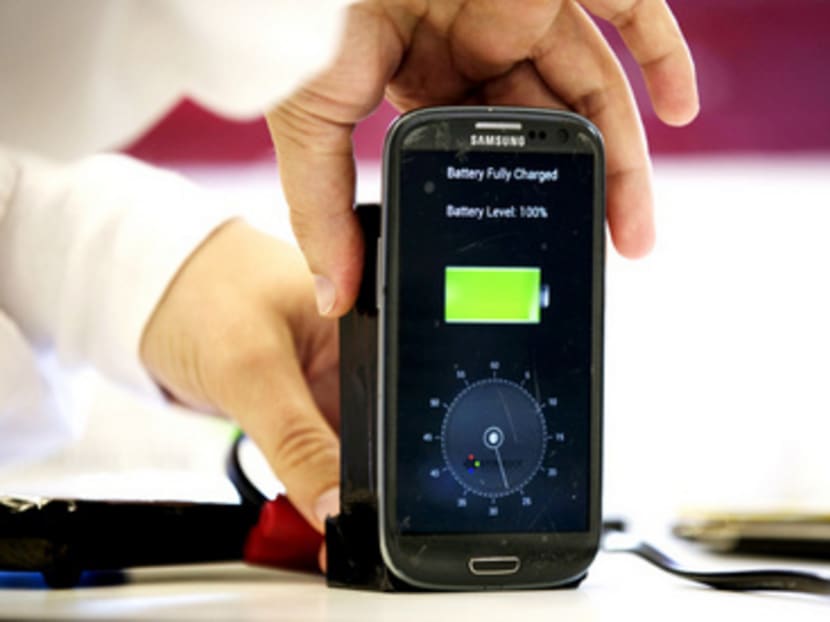New battery charges fully in one minute, will not catch fire
CALIFORNIA — The frustration of waiting hours for your smartphone or tablet to fully recharge could soon be a thing of the past, thanks to a new battery made from aluminium that can be charged in under one minute. It is also greener and safer, scientists said.

A lab worker disconnects from a charger a mobile phone, displaying a timer indicating that the battery was fully charged under 30 seconds, at the headquarters of StoreDot in Tel Aviv October 23, 2014. The Israeli company says it has developed technology that can charge a mobile phone in a few seconds and an electric car in minutes, advances that could transform two of the world's most dynamic consumer industries. Picture taken October 23, 2014. REUTERS/Finbarr O'Reilly (ISRAEL - Tags: BUSINESS SCIENCE TECHNOLOGY TRANSPORT TELECOMS)
CALIFORNIA — The frustration of waiting hours for your smartphone or tablet to fully recharge could soon be a thing of the past, thanks to a new battery made from aluminium that can be charged in under one minute. It is also greener and safer, scientists said.
Conventional alkaline batteries are bad for the environment, while lithium-ion batteries used in millions of laptops and smartphones can unexpectedly burst into flames and take a long time to charge.
In a breakthrough, Stanford University has invented the first high-performance aluminium battery that is fast-charging, long-lasting and inexpensive. It is also flexible and can be used in new folding devices in development.
The only stumbling block is that it has only half the voltage of present lithium-ion batteries, the study published in the journal Nature revealed.
“We have developed a rechargeable aluminium battery that may replace existing storage devices, such as alkaline batteries, which are bad for the environment, and lithium-ion batteries, which occasionally burst into flames,” said chemistry professor Hongjie Dai. “Our new battery won’t catch fire, even if you drill through it.”
Aluminium is cheap and has low flammability and high-charge storage capacity. But scientists have struggled to make commercially viable aluminium-ion batteries because of the difficulty in finding materials that can produce sufficient voltage after repeated cycles of charging and discharging.
The aluminium-ion battery consists of two electrodes: A negatively charged anode made of aluminium and a positively charged graphite cathode along with an ionic liquid electrolyte, inside a flexible polymer-coated pouch.
“The electrolyte is basically a salt that’s liquid at room temperature, so it’s very safe,” said Stanford graduate student Ming Gong.
“Lithium-ion batteries can be a fire hazard. ... We have videos showing that you can drill through the aluminium battery pouch, and it will continue working for a while longer without catching fire. But lithium batteries can go off in an unpredictable manner in the air, the car or in your pocket. Besides safety, we have achieved major breakthroughs in aluminium battery performance,” said Mr Gong.
And while lithium-ion batteries can take hours to charge, the new battery has “unprecedented charging times” of one minute.
Unlike other prototypes which die after only 100 charges, the Stanford battery can withstand more than 7,500 cycles without any loss of capacity. By comparison, a typical lithium-ion battery lasts about 1,000 cycles.
“Another feature of the aluminium battery is flexibility,”Mr Gong said. “You can bend it and fold it, so it has the potential for use in flexible electronic devices. Aluminium is also a cheaper metal than lithium.”
Prof Dai said that improving the cathode material could eventually increase the voltage and energy density of the aluminium battery. “Otherwise, our battery has everything else you’d dream that a battery should have: Inexpensive electrodes, good safety, high-speed charging, flexibility and long cycle life. I see this as a new battery in its early days. It’s quite exciting.” THE daily TELEGRAPH





